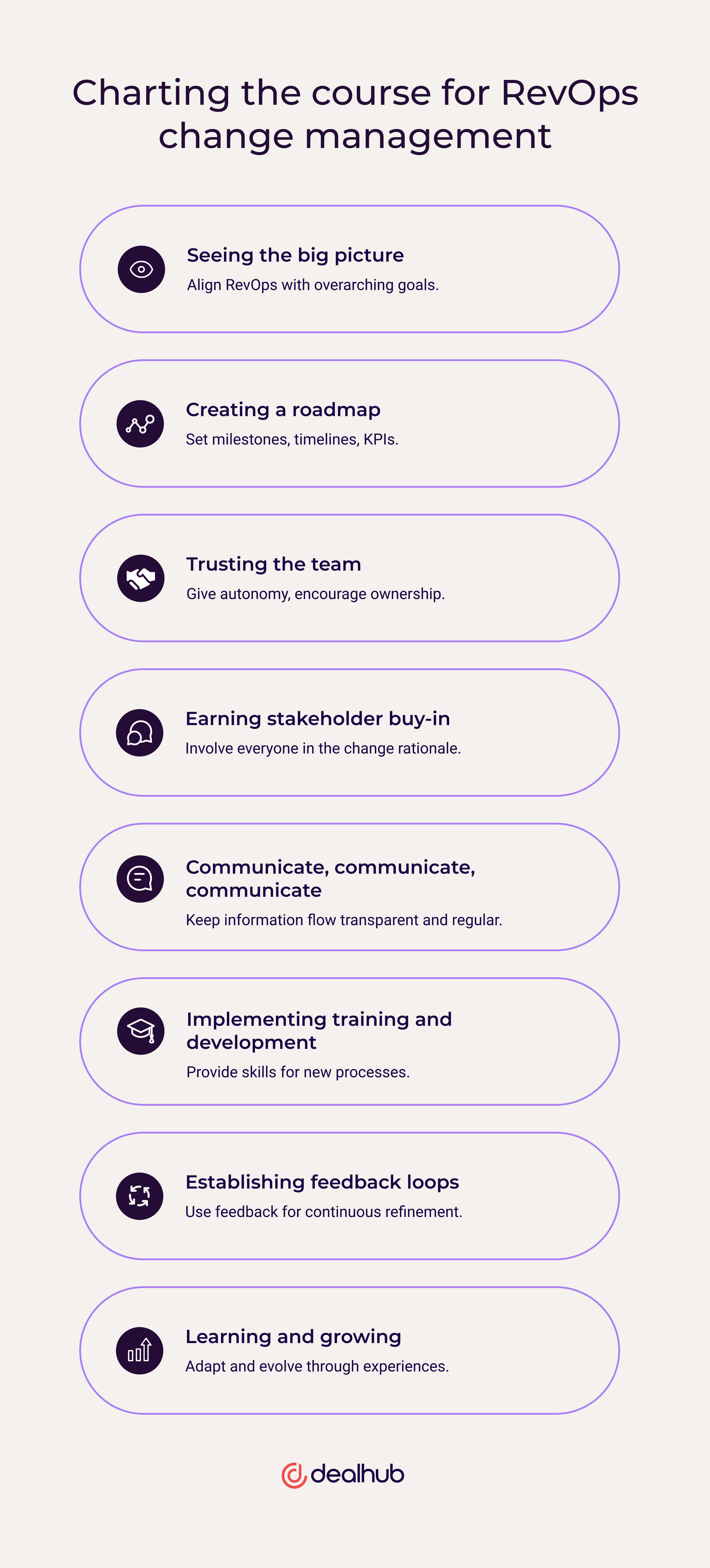From our conversations with CROs and Sales Operations leaders, we have gleaned insights into the change management process, specifically the RevOps transition. Drawing from industry leaders who’ve pioneered this path, we offer a roadmap, pinpointing key milestones and strategies for success.
From securing stakeholder buy-in and fine-tuning communication to establishing feedback channels, we cover the essentials of the RevOps journey. Whether you’re steering the ship, part of the crew, or keenly observing from the shore, we’ve got insights to guide you.
Demystifying change management in revenue operations
Change management, in any context, is about navigating transitions smoothly and effectively. But when we talk about Revenue Operations or RevOps, the stakes are even higher. Why? Because RevOps isn’t just about introducing new tools or tweaking a few processes; it’s about reimagining how different teams in the company work together.

Having established the significance of RevOps, it’s essential to understand the mechanisms that drive its successful implementation.
The RevOps landscape
RevOps is still a budding concept for many. Yet, its promise of streamlined operations and enhanced collaboration has become a hot topic in boardrooms.
Historically, sales, marketing, and customer success have operated in silos, each with its own set of goals, KPIs, and tools. This siloed approach can lead to inefficiencies, miscommunication, and missed opportunities. RevOps aims to dismantle these barriers, creating a unified front where all departments work harmoniously toward shared objectives. As organizations embark on this RevOps journey, they’re not just looking at operational changes; they’re looking at a cultural shift. And that’s where change management steps in.
The role of change management
When we talk about change management strategy in the context of RevOps, it’s not just about rolling out new software or tweaking workflows. It goes much deeper. At its heart, it’s about fostering a collaborative mindset. This means teams move beyond being isolated units and start seeing themselves as vital components of a unified whole. This also requires redefining processes, integrating tools for seamless communication, championing the adoption of new software, and ensuring agility as RevOps evolves. Feedback remains crucial, addressing challenges promptly for a smooth transition.
Charting the course for RevOps change management
Embarking on the RevOps journey requires a clear direction and strategy. Let’s break down the essential steps to navigate this transformation effectively:

Seeing the big picture
Before diving into the specifics, it’s crucial to understand the broader organizational goals. How does RevOps align with the company’s vision and value creation? This clarity will serve as the north star throughout the transition for the management team.
Creating a roadmap
Lack of trust in leadership is one of the biggest reasons for change resistance. A detailed plan with milestones, timelines, and KPIs will make the transition systematic and measurable. This roadmap will keep the entire journey on course and help foster trust in the leadership team.
Trusting the team
A top-down approach won’t work here. Trusting your team is essential, giving them the autonomy and resources they need. This trust fosters ownership and accountability.
Earning stakeholder buy-in
Every stakeholder, from business leaders to frontline employees, should understand the ‘why’ behind the business strategy. When staff are truly invested in operational change it is 30 percent more likely to succeed. Regular town halls, workshops, and feedback sessions can help achieve buy-in.
Communicate, communicate, communicate
In the face of change, rumors and misinformation can run rampant. Combat this with transparent, regular, and multi-channel communication. Ensure everyone is informed, whether it’s by newsletters, webinars, or team meetings.
Implementing training and development
New processes often require new skills. Invest in training programs, workshops, and e-learning modules to ensure your team is well-equipped to handle the nuances of RevOps.
Establishing feedback loops
Change is a two-way street. Regularly solicit feedback from all levels of the organization. This feedback will be invaluable in making real-time adjustments and ensuring a smooth transition.
Learning and growing
The RevOps journey is iterative. There will be successes and setbacks. The key is to learn from each experience, continuously refining the approach for better outcomes.
After understanding the foundational role of change management in RevOps, seeing these principles in action is beneficial. Let’s explore a real-world example from revenue leaders.
Change management best practices from revenue leaders
As we navigate the RevOps journey, learning from those who’ve treaded these waters is invaluable. Drawing from our RevAmp podcast series, we’ve captured key insights from industry leaders who’ve mastered the art of RevOps transformation:
Building trust with Kostja Mirkovic
Kostja’s approach to RevOps is rooted in understanding and collaboration.
- Consultative approach: Kostja emphasizes donning a consultant’s hat when addressing challenges. Instead of dictating solutions, he believes in engaging teams in dialogue – making them key stakeholders, understanding their pain points, and collaboratively finding solutions.
- Translating actions to financial outcomes: It is important to bridge the gap between actions and their financial implications. By doing so, teams can see the direct impact of their efforts, fostering motivation and alignment.
- Understanding key business drivers: To build trust, being in tune with what drives the business is essential. Ensure RevOps strategies resonate with the broader company vision by zeroing in on the core drivers of the business.
Scaling revenue operations with Allyson Clark
Allyson’s journey in scaling RevOps highlights the importance of structure and adaptability.
- Structuring the chaos: As organizations scale, challenges around pricing, contracts, and proposals can become overwhelming. Allyson emphasizes the need for a structured approach, ensuring that processes are streamlined and efficient.
- Leveraging the right tools: Tools like Salesforce and DocuSign Gen aren’t just software; they’re enablers. The importance of harnessing an integrated revenue tech stack to automate, optimize, and ensure consistency across operations cannot be understated in the company’s digital transformation.
- Embracing continuous change: In the fast-paced world of RevOps, stagnation is not an option. The ethos of continuous adaptation must be championed, ensuring operations are always in sync with market demands and organizational needs.
Cultivating a strong sales culture with Saro Zargarian
Saro’s insights into RevOps emphasize the significance of a robust sales culture, holistic understanding, and the need for innovation.
- Holistic understanding of business: Saro underscores the importance of grasping the entire business model. By understanding everything from high-level objectives to granular data, RevOps can act as a versatile tool, driving alignment and efficiency.
- The power of a strong sales culture: Beyond just direct sales, Saro believes in the ripple effects of a vibrant sales culture. Such an environment boosts revenue and fosters growth, collaboration, and a shared sense of purpose.
- Innovation at the heart of RevOps: Saro stresses the need to stay innovative in the ever-evolving landscape of business. This means keeping abreast of market trends, being agile, and ensuring RevOps remains a dynamic and adaptive function.
While insights from industry leaders provide a roadmap, the real challenge lies in embracing and implementing change at the ground level.
Embracing change management
Change management is all about unlocking potential. When RevOps leaders effectively harness change management, they pave the way for a myriad of benefits:
Seamless collaboration
Gone are the days of isolated departments. An effective change management plan breaks down barriers, allowing teams to collaborate effortlessly. This ensures a unified approach, making the customer journey consistent and delightful.
Operational efficiency
Efficiency is the cornerstone of RevOps. By streamlining and automating business processes and eliminating redundancies, decisions are made faster, and actions are executed more swiftly. This not only saves time but also resources, driving the organization forward.
Fostering innovation
In a cohesive environment, creativity thrives. Teams feel empowered to share ideas, brainstorm, and innovate. This collective intelligence leads to groundbreaking solutions, setting the company apart from competitors.
Boosting employee morale
Change, when managed well, can be invigorating. Employees who feel they’re part of the transformation journey, rather than mere spectators, experience heightened morale. This positive atmosphere enhances productivity and fosters loyalty, reducing turnover.
Driving revenue growth
At the heart of RevOps is the ultimate goal: revenue growth. When all the cogs in the machine work harmoniously, the result is evident in the bottom line. Enhanced collaboration, efficiency, and innovation all converge to drive substantial revenue growth, marking the success of the RevOps journey.
With these benefits of change management in mind, let’s reflect on the overarching impact of the RevOps revolution.
RevOps: the art and science of change management
At the heart of the RevOps revolution lies the art and science of change management. A clear direction and robust strategy are the bedrock of a successful transition. This isn’t a path to tread lightly or without preparation. Best practices, such as championing seamless collaboration across departments and establishing robust feedback mechanisms, serve as guiding beacons, ensuring the transition is not just smooth but also sustainable. When executed with precision, the culmination of these efforts is a cohesive operational framework where sales, marketing, and customer success converge, propelling organizations to new heights of efficiency and growth.
As we reflect on the profound impact of RevOps and change management, we invite you to explore further and join the vanguard of businesses harnessing the full potential of RevOps. Are you ready to be part of the revolution?





